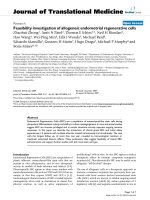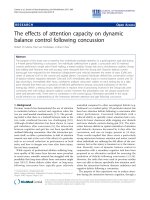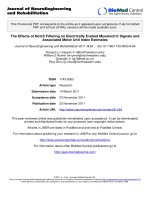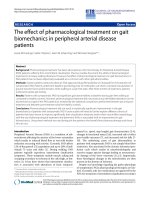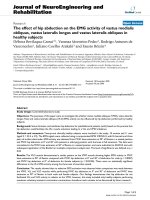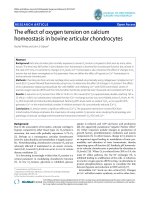Báo cáo hóa học: " Multiscale investigation of graphene layers on 6H-SiC(000-1)" pot
Bạn đang xem bản rút gọn của tài liệu. Xem và tải ngay bản đầy đủ của tài liệu tại đây (1.36 MB, 8 trang )
NANO EXPRESS Open Access
Multiscale investigation of graphene layers on
6H-SiC(000-1)
Antoine Tiberj
1*
, Jean-Roch Huntzinger
1
, Jean Camassel
1
, Fanny Hiebel
2
, Ather Mahmood
2
, Pierre Mallet
2
,
Cecile Naud
2
, Jean-Yves Veuillen
2*
Abstract
In this article, a multiscale investigation of few graphene layers grown on 6H-SiC(000-1) under ultrahigh vacuum
(UHV) conditions is presented. At 100-μm scale, the authors show that the UHV growth yields few layer graphene
(FLG) with an average thickness given by Auger spectroscopy between 1 and 2 graphene planes. At the same
scale, electron diffraction reveals a significant rotational disorder between the first graphene layer and the SiC
surface, although well-defined preferred orientations exist. This is confirmed at the nanometer scale by scanning
tunneling microscopy (STM). Finally, STM (at the nm scale) and Raman spectroscopy (at the μm scale) show that
the FLG stacking is turbostratic, and that the domain size of the crystallites ranges from 10 to 100 nm. The most
striking result is that the FLGs experience a strong compressive stress that is seldom observed for graphene grown
on the C face of SiC substrates.
Introduction
The unique electronic, optical, and mechanical proper-
ties of graphene [1-3] give rise to an intense research
activity for both scientific and technological purposes.
Among these research activities, special effort is devoted
to develop preparation techniques [4-12] which yield
large-scale graphene wafers of high quality and unifor-
mity. Today, one of the most promising methods for
microelectronic applications consists in a controlled
sublimat ion of a few Si atomic layers from a single crys-
talline SiC surface [9-20]. The remaining C atoms rear-
range themselves and form few layer graphene (FLG),
often called “epitaxial graphene.” Such FLG samples can
be grown either on the Si face (0001) of a SiC substr ate
or on the C face (000-1). Graphene growth on the Si
face has been extensively studied in the last few years
[9-12]. It has been shown that large, homogeneous gra-
phene monolayers and bilayers can be obtained on top
of a
63 6330× R
SiC surface reconstruction [13-15].
ThegrapheneplanesareBernal (AB) stacked. The
interface between the first graphene plane and the SiC
surface is composed of an intermediate C-rich layer hav-
ing covalent bonds with Si atoms of the substrate
[13-15]. Epi taxial graphene on t he Si-face is usua lly
highly n-type doped (around 10
13
cm
-2
)withalowcar-
rier mobility (usually few thousands cm
2
V
-1
s
-1
).
On the C face, the situation is completely different.
There is no need for a buffer layer anymore but two dif-
ferent pristine surface reconstruc tions exist below the
graphene layers: (2 × 2)
C
and (3 × 3) SiC reconstruc-
tions, and t he graphene layers h ave several orientations
on top of each surface reconstruction [16-18]. The inter-
action between graphene layers and the C face of SiC
substrate is reduced compared to the one existing on
the Si face. Graphene grown on (3 × 3) SiC surfaces
experience the weakest interaction with the underlying
substrate. This weaker interaction between the graphen e
layers and the SiC substrate may be one of the reason
for the better carrier mobility measured on epitaxial gra-
phene on C-face (27000 cm
2
V
-1
s
-1
)[19].Italso
explains why, long, self-ordered, strain-free graphene
ribbons can be grown on large reconstructed terraces
[20]. Besides, it has been shown that the interaction
with the environment impacts also the transport proper-
ties of exfoliated graphene [21]. It is therefore of pri-
mary importance to study the graphene/SiC interaction.
ThefocusofthisarticlewillbeonFLGgrownin
* Correspondence: ; jean-yves.
1
Groupe d’Etude des Semiconducteurs, UMR5650 CNRS-Université
Montpellier II, cc074, Place Eugène Bataillon, 34095 Montpellier Cedex 5,
France.
2
Institut Néel, CNRS-UJF, Boîte Postale 166, 38042 Grenoble Cedex 9, France.
Full list of author information is available at the end of the article
Tiberj et al. Nanoscale Research Letters 2011, 6:171
/>© 2011 Tiberj et al; licensee Springer. T his is an Open Access article distributed under the terms of the Creative Commons Attribution
License ( nses/by/2.0), which permits unre stricted use, distribution, and reproduction in any medium,
provided the original work is properly cited.
ultrahigh vacuum (UHV) on 6H-SiC (000-1). Surface
reconstruction will be probed by low-energy electron
diffraction (LEED), Auger electron spectroscopy (AES),
and scanning tunneling microscopy (STM). Thanks to
previous studies [17,18], SiC surface reconstruction, gra-
phene orientation, and stacking can be determined from
the Moiré patterns observed in STM. The observed
crystallite size and stacking will be compared to those
from Raman spectroscopy performed on the same sam-
ple. Despite the different sizes of the probed area
between STM (microscopic) and Raman spectroscopy
(macroscopic), a very good agreement has been found.
Graphene growth
The sample graphitization and first characterization
(STM, LEED, and AES) were performed in situ under
UHV conditions according to the procedure of ref. [18].
The surface of the 6H-SiC( 000-1) sample (n doped, pur-
chased from NovaSiC) was first cleaned by a 850°C
annealing treatment under a Si flux. The usual SiC(3 ×
3) reconstruction [16] was obtained by further heating
at 950-1000°C. Graphitization of the surface was per-
formed by annealing at increased power until a graphitic
signal is detected by LEED. The typical diffraction pat-
terns(showninFigure1)revealbothSiC(3×3)and
SiC(2 × 2) spots indicated by arrows with SiC(1 × 1)
spots being indicated by circles. The FLGs exhibit a
ringlike LEED pattern with modulated intensity
indicated by the dashed circle. It evidences a significant
distributio n of azimuthal disorientation for the fi rst gra-
phene plane compared to the SiC lattice. However,
some preferential orientations exist, as shown by the
more intense spots (at 30° and predominantly around
14°). AES performed on this sample gives an average
coverage of the surface of 1 to 2 graphene layers.
Scanning tunneling microscopy
STM measurements were done at room temperature
using mechanically cut PtIr tips. Typical STM images
are gathered in Figure 2 in which a large diversity of
graphene layers can be observed. First, on the edge of
the SiC reconstructed steps, the growth rate is much
higher, and small multilayers which are a few tens of
nm width appear (Figure 2a). On the terraces, mono
andbilayerscoverthemajorityofthesurfaceandare
much wider (up to 100 nm). Few small areas are not
graphitized, and the usual SiC(3 × 3) surface reconstruc-
tion can be observed (Figure 2d) [16]. The (3 × 3) is also
seen on Figure 2c through the graphene monolayer
because of the high sample bias (-2.5 V) [17,18]. In
Figure 2b,c one can also clearly distinguish some Moiré
patterns (MP) on graphene mono, bi, and multilayers.
Such MPs have several origins. The MP observed on the
monolayer graphene comes from disorientation between
the first graphene plane and the SiC(3 × 3) surface. The
disorientation angle determines the period of the MP
: (1x1) SiC
: (3x3) SiC
: (2x2) SiC
: graphène.
64 eV
95 eV
Figure 1 LEED patterns of a 6H-SiC(000-1) sample after graphitization. The circles in dicate the (1 × 1) SiC spots, the white arrows the (3 ×
3) SiC spots, and the rose arrows point to faint SiC(2 × 2)
C
spots. The dashed (quarter) circle shows the ringlike pattern of graphene. The
modulated intensity of FLGs signal corresponds to the distribution of rotation angles for the first graphene layer compared to the SiC surface
with some preferential orientations (the brightest spots).
Tiberj et al. Nanoscale Research Letters 2011, 6:171
/>Page 2 of 8
based on a classical model previously described [18]. For
instance, the MP for the island in the lower right part of
Figure 2b corresponds to a rotation angle of 11.2°. The
MPs observed on the multilayers come both from t he
interface (as above) and from rotational stacking faults
between the different graphene planes, which is charac-
teristic of a turbostratic stacking. Such disorientations
between the graphene sheets and the SiC substrate con-
firm the weak coupling between the graphene planes, and
also between the FLGs and the SiC substrate. This is cor-
roborated by the presence of wrinkles seen in Figure 2d.
Finally, the top graphene plane on Figure 2c is a continu-
ous sheet between the mono and the bilayer graphenes.
Raman spectroscopy
To investigate the quality and thickness uniformity of
the FLG, micro-Raman spectroscopy and microtransmis-
sion measurements were simultaneously performed.
(a)
(b)
(c)
(d)
Figure 2 STM images of a 6H-SiC(000-1) sample after graphitization (same sample as in figure 1). (a) 300 × 300 nm
2
STM image of few
layers of graphene grown on 6H-SiC (000-1). The brightest areas correspond to multilayers grown on a step edge, the right part corresponds to
monolayer graphene. (b) 150 × 150 nm
2
zoom of the top right corner of image (a). The dark areas correspond to monolayer graphene grown
on (3 × 3) SiC-reconstructed surface. MPs are seen on the monolayer and on the multilayers (the brighter area) indicating that the first graphene
layer is disoriented compared to the SiC surface and that the multilayers are “twisted” (turbostratic stacking). (c) 50 × 50 nm
2
STM images of a
bilayer and a monolayer. The turbostratic stacking of the bilayer is revealed by a long-range MP with a wavelength of 4 nm. On the monolayer,
one can only see the (3 × 3) SiC surface reconstruction pattern due to the high tunnel voltage (-2.5 V). It should be stressed that the top
graphene plane is continuous between the mono and the bilayer. (d) 300 × 300 nm
2
STM image showing the distribution of FLG grown
ranging from the bare (3 × 3) SiC surface (0L), monolayers (1L), and bilayers (2L). On the left, a 1-nm high wrinkle can be seen on a bilayer. The
bright horizontal line corresponds to a tip change.
Tiberj et al. Nanoscale Research Letters 2011, 6:171
/>Page 3 of 8
As has already been shown [20], these two techniques
can be easily combined by inserting a low-noise photo-
diode between the SiC substrate and the XYZ piezoelec-
tric stage. It is then possible to measure at the same
time, during the acquisition of Raman spectra, using the
same laser beam as a probe, the power transmitted
through the sample. Raman spectra were collected at
room temperature using a Jobin Yvon-Horiba T64000
spectrometer in the confocal mode, with a ×100 micro-
scope objective. The 514-nm line of an Ar ion-laser was
used for excitation. The spot size was 1 μm, with 1-mW
incident power under the objective. Using this original
combination of techni ques, a 1 6 × 16 μm
2
mapping of
the FLG area located at the center of the sample was
performed. The step size was 0.25 μm along both X and
Y directions. Since no bare SiC surface could be found
at the probe size, a SiC reference spectrum was col-
lected by focusing the laser beam in the SiC substrate
deeper than the confocal field depth. FLG’s Raman spec-
tra were obtained by subtracting the SiC reference spec-
trum from the experimental spectra. Typical spectra,
collected on the thinnest and thickest FLG parts, are
compared to the one of a highly oriented pyrolytic gra-
phite (HOPG) sample in Figure 3. On these spectra, D,
G, and 2D bands can easily be observed at 1380, 1610,
and 2750 cm
-1
, respectively. These thr ee bands are blue
shifted compared with standard FLG and HOPG Raman
spectra. As discussed later, this blueshift can only be
explained by a high compressive strain of the graphene
lattice. The 2D band has a single Lorentzian shape
meaning that the FLG stackin g is not Bernal but, rath er,
turbostratic. This first observation is in perfect agree-
ment with the previous S TM results. The D band
around 1380 cm
-1
comes from the breakdown of the
wavevector selection rule and reveals the presence of
crystalline defects inside o r at the edges of FLG flakes.
The in-plane size of the crystallites can be deduced
from the ratio between the G and D band integrated
intensities (I
D
/I
G
). Using the expression given by
Pimenta et al. [22] the domain size map was extracted,
as shown in Figure 4b.
L
I
I
a
nm
laser
nm
D
G
()
=×
()
⎛
⎝
⎜
⎞
⎠
⎟
−
−
24 10
10
4
1
.
(1)
The in-plane sizes of the crystallites L
a
ranges from 20
to 60 nm, which are in excellent agreement with pre-
vious STM observations.
To estimate the average graphene thickness, one
should use the relative extinction deduced from our
microtransmission measurements [20]. Unfortunately,
on this sample, no bare SiC substrate could be me a-
sured. It was then impossible to measure the trans-
mitted power through the SiC substrate. Hopefully,
from previous results [ 20] it is also known that the
thickness can be roughly estimated from the G band-
integrated intensity. In this case, for thin FLG ( less than
five layers), the estimated error is one layer, while, for
thicker samples, the estimated thickness may have a fac-
tor two error. The following (empirical) relationship was
used, which correspond s to the experimental configura-
tion of this study:
n
I
I
=×
G
G HOPG
1
003.
(2)
Laser power fluctuations are corrected thanks to an
additional low-noise photodiode that measures the laser
power during the acquisition of t he Raman map, and
the estim ated thickness found is shown in Figure 4a. At
the scale of the Raman probe, the FLG coverage ranges
from two to seven graphene planes, with an average of
two to three graphene planes. This is one monolayer
thicker than the value deduced from AES and STM
experiments. Such discrepancy occurs because of the
different sizes of areas probed by Raman spectroscopy
(1 μm), AES (100 μm), and STM (few nm up to 300
nm). Moreover, STM focuses always on the most inter -
esting area of the sample (i.e., the thinnest FLG) where
bare SiC surface, mono, and few layers can be measured.
However, it has already been shown in Figure 2a,b t hat
thick multilayer flakes grow close to the edges of SiC
steps. This is not peculiar to these images. The growth
Figure 3 Raman spe ctra of a HOPG sample ( blue line), the
thickest FLG (black line), and the thinnest FLG (red line). The
FLG’s spectra are extracted from the 16 × 16 μm
2
Raman mapping
collected in the center of the sample. D band can be seen around
1350 cm
-1
indicating the presence of crystalline defects/disorder in
the grown FLG. The 2D band around 2750 cm
-1
has a single
Lorentzian shape that is the fingerprint of a turbostratic stacking.
Finally, both G and 2D bands are shifted to high energy compared
to the HOPG spectrum. This up shift evidences that FLGs experience
a high compressive stress.
Tiberj et al. Nanoscale Research Letters 2011, 6:171
/>Page 4 of 8
rate is always higher at step edges. It can also be stated
from Figure 4a that the thickest FLGs measured by
Raman spectroscopy are located at discrete spots with a
small lateral extension (< 2 μm). This is the case of mul-
tilayers seen in Figure 2a, while the majority of the
probed area corresponds to FLG with less than three
graphene planes. As previously said, using only the G
band-integrated intensity, one can have an error of one
graphene plane. The thickness estimated from Raman
mapping is then consistent with STM results. C oncern-
ing AES, the agreement is poorer, and it would be inter-
esting to perform a more detailed cross calibration o f
AES vs Raman spectroscopy to better understand the
correlation between these two different techniques.
Fin ally, the most striking result is the strong blueshift
observed on this FLG. The D band lies around 1380
cm
-1
, the G band around 1610 cm
-1
,andthe2Dband
around 2750 cm
-1
whereas neutral relaxed graphene has
a D band around 1350 cm
-1
,aGbandcenteredat1582
cm
-1
, and a 2D band at 2690 cm
-1
. The average up shift
is then of 28 cm
-1
for the G band, and of 60 (30) cm
-1
for the 2D (D) band, respectively. The G and 2D band
Raman shift maps are shown in Figure 4c,d. The G
band Raman shift ranges from 1598 to 1626 cm
-1
and
the2Dbandfrom2736to2764cm
-1
.Suchhighblue-
shift cannot be explained by a doping of the graphene
layers. Although high p-type doping (3 × 10
13
cm
-2
) and
n-type doping (4 × 10
13
cm
-2
) induce a blueshift of the
G band up to 1610 cm
-1
, the G band is then narrowed
with a FWHM around 8 cm
-1
[23]. In this case the
FWHM of the G band ranges from 15 to 35 cm
-1
.This
G band b roadeni ng refutes the high doping hypothesis.
The doping hypothesis is also refuted by the 2D band
position that cannot be explained by the n-type doping
that shifts the 2D band to lower energies (down to 2660
cm
-1
)andbythep-type doping that shifts the 2D band
Number of Layers Domain size
G band Raman shift 2D band Raman shift
(a)
(b)
(c)
(d)
Figure 4 16 × 16 μm
2
Raman maps collected with a 0.25-μmstepsize. (a) FLG thickness derived from the normalized integrated intensity
of the G band. The thickness is comprised between two and six graphene planes with an average thickness of three planes. (b) Domain size of
the graphene crystallites deduced from the I
D
/I
G
ratio. The in-plane size ranges from 20 to 60 nm. (c, d) Raman shift of the G and 2D bands,
respectively. The positions of both bands are shifted to higher energies. The G band is around 1610 cm
-1
and the 2D band around 2750 cm
-1
.
This high up shift can only be explained by a high in-plane compressive strain of the graphene lattice.
Tiberj et al. Nanoscale Research Letters 2011, 6:171
/>Page 5 of 8
up to 2700 cm
-1
, which is much smaller than the
observed shifts. These blueshifts can actually be
explained by a high compressive strain of the graphene
lattice. This strain must originate from the strong differ-
ence in the in-plane thermal expansion coefficients of
the SiC and the graphene. It is crea ted during the cool-
ing down of the sample after the growth. It can be
assumed that it is biaxial. The strain and stress can then
be deduced from the relationships of Table 1 [3,24].
The frequency shifts of the G and 2D are given for a
biaxial strain of 1% and for a biaxial stress of 1 GPa.
Using these relationships, it can be estimated from the
G band that the strain ranges from -0.2 to -0.7% with
an average of -0.5%. The corresponding stress values
rangefrom-3to-8.7GPawithanaverageof-6GPa.
From the 2D band, a str ain comprised between -0.3 and
-0.5% with an average of -0.4% is found. The corre-
sponding stress ranges from -3.7 up to -6 GPa with an
average of -5 GPa. The strain/stress derived from the
2D band is slightly smaller than the one deduced from
the G band. It can arise from the uncertainty on the
graphene/graphite Grüneisen parameters [3] and maybe
from a small FLG doping that can induce a small shift
of both bands. Nevertheless, it can be concluded from
this high up shift of the D, G, and 2D bands that FLG
are subjected to a high compressive strain (stress) with
an average from around -0.4 to -0.5% (-5 to -6 GPa).
The most probable origin is the thermal stress due to
the cooling down of the sample after the growth. This
compressive stress might be considered as being in con-
tradiction with the weak interaction between graphene
layers and the underlying substrate that was shown by
LEED and STM experiments. The most likely hypothesis
is that graphene crystallite edges are bound to the SiC
surface. This bonding would induce this strong thermal
stress, but let graphene layers free to grow with the
wide distribution of disorientation angles revealed by
STM and LEED results. To check this hypothesis, STM
images of the graphene edges were recorded and are
shown in Figure 5. U nfortunately, the SiC surface and
the graphene lattice cannot be imaged simultaneously
since graphene is only clearly resolved at low bias within
the gap of the SiC(3 × 3) surface [18]. In Figure 5a, the
SiC surface is probed at high tunnel voltage (-2.5 V),
and the bare (3 × 3) SiC surface can be distinguished
from the (3 × 3) SiC surface with a graphene monolayer
on top. It can also be stated that the edges of the
Table 1 Frequency shifts of the G and 2D bands for a
biaxial strain of 1% or a biaxial stress of 1 GPa [3,24]
biax
= 1%
biax
GPa= 1
Δ
G
biax 1
cm=−
−
60 Δ
G
biax 1
cm=−
−
48.
Δ
2
153
D
biax 1
cm=−
−
Δ
G
biax 1
cm=−
−
12 3.
Figure 5 STM images of the edges of the graphene i slands. (a) 23 × 23 nm
2
STM image of a monolayer on top of the (3 × 3) SiC-
reconstructed surface. This image was recorded at a high tunnel voltage (-2.5 V) with a current of 0.2 nA. With such high voltage, only the (3 ×
3) SiC surface can be imaged on the bare SiC and through the monolayer. One can still distinguish that the edges of the monolayer are brighter
than the center. It corresponds to a height difference of 40 pm. (b) To get a more detailed image of the edges, a 6.6 × 4.6 nm
2
STM image was
recorded at low tunnel voltage (+10 mV) with a current of 0.1 nA. In these experimental conditions, the graphene lattice can be probed with an
atomic resolution. The graphene edge is folded and bent towards the SiC surface. The height of the fold is 50 pm. This particular shape is
consistent with the compressive stress deduced from the Raman spectra. This compressive stress is occured by the thermal stress because of the
cooling down of the sample after the growth and because the graphene edges seem to be bound to the SiC surface.
Tiberj et al. Nanoscale Research Letters 2011, 6:171
/>Page 6 of 8
graphene island are higher than the core by 40 pm. At
lower tunnel voltage (+10 mV), a detailed image of the
graphene edges was recorded with atomic resolution on
the graphene lattice. On this image, it can be clearly
observed that the graphene sheet is folded and that its
edges are bent towards the SiC surface. The fold is 50
pm higher than the island core at this low bias, which is
similar to the high bias value and thus should reflect the
topography of the graphene edge. This step height is
much smaller than the wrinkles that are usually seen o n
graphene grown on the C face. However, the fold and
the bending can indicate that the graphene edges are
bound to the SiC substrate. This edge bonding can also
explain the thermal compressive stress of these gra-
phene crystallites after cooling down the sample. Usually
on the C face, the elastic energy associated with the
stress is often relaxed by the formation of wrinkles. It is
not the case here because of the small graphene crystal-
lite sizes. The authors observed indeed only one wrinkle
on Figure 2d. The compressive stress is not relaxed
because the elastic energy to be relaxed is proportional
to the domain area and is not high enough to compen-
sate the energy cost of the wrinkle formation.
Conclusion
The FLG has been grown on 6H-SiC (000-1) in UHV
conditions. An average thickness of one to two graphene
planes was found from AES, whereas Raman s pectro-
scopy results indicate an average thickness of two to
three graphene planes. This small discrepancy might
occur because of the uncertainty of one to two layers
for thickness determined from Raman spectroscopy and
from the difference of the spot size between these two
techniques. LEED and STM experiments show (i) a (3 ×
3) SiC surface reconstruction, (ii) a wide distribution o f
disorientation between the first graphene sheet and the
SiC surface, and (iii) rotational stacking fault between
the graphene layers corresponding to a turbostratic
stacking for the multilayers. The single Lorentzian shape
of the 2D Raman band measured on these FLG confirms
this turbostrat ic stacking. The FLG domain size
(deduced from the I
D
/I
G
ratio) ranges from 20 to
60 nm, which is in excellent agreement with the gra-
phene crystallites size probed by STM. Finally, the most
striking result is that the D, G, and 2D bands are highly
blue shifted (+30, +28, and + 60 cm
-1
, respectively). This
means that the graphene lattice is highly compressively
strained (around -0.4/-0.5%). Usually, FLG grown on the
C face of S iC are fully relaxed by forming wrinkles to
release the thermal stress during the cooling down of
the sample after the growth. For this particular case, the
strain might arise because graphene crystallite edges are
bound to the SiC surface.
Abbreviations
AES: Auger electron spectroscopy; FLG: few layer graphene; HOPG: highly
oriented pyrolytic graphite; LEED: low energy electron diffraction; STM:
scanning tunneling microscopy; UHV: ultrahigh vacuum.
Acknowledgements
This study was financially supported by the French ANR ("GraphSiC” Project
No. ANR-07-BLAN-0161), and by the Région Rhône-Alpes ("Cible07” and
“Cible08” programs). F.H. holds a doctoral support from la Région Rhône-
Alpes.
Author details
1
Groupe d’Etude des Semiconducteurs, UMR5650 CNRS-Université
Montpellier II, cc074, Place Eugène Bataillon, 34095 Montpellier Cedex 5,
France.
2
Institut Néel, CNRS-UJF, Boîte Postale 166, 38042 Grenoble Cedex 9,
France.
Authors’ contributions
FH and AM prepared the samples and carried out the LEED, Auger and STM
measurements. FH and PM performed the analysis of the LEED, Auger and
STM data. AT and JRH carried out the micro Raman spectroscopy and
microtransmission experiments. AT, JRH and JC performed the analysis of
the Raman and transmission data. AT drafted the manuscript. JC, JRH, CN
and JYV participated in the writing of the manuscript. All authors read and
approved the final manuscript.
Competing interests
The authors declare that they have no competing interests.
Received: 6 September 2010 Accepted: 24 February 2011
Published: 24 February 2011
References
1. Castro Neto AH, Guinea F, Peres NMR, Novoselov KS, Geim AK: The
electronic properties of graphene. Rev Mod Phys 2009, 81:109.
2. Nair RR, Blake P, Grigorenko AN, Novoselov KS, Booth TJ, Stauber T,
Peres NMR, Geim AK: Fine structure constant defines visual transparency
of graphene. Science 2008, 320:1308.
3. Ferralis N: Probing Mechanical properties of graphene with Raman
spectroscopy. J Mater Sci 2010, 45:5135.
4. Novoselov KS, Geim AK, Morozov SV, Jiang D, Zhang Y, Dubonos SV,
Grigorieva IV, Firsov AA: Electric field effect in atomically thin carbon
films. Science 2004, 306:666.
5. Hernandez Y, Nicolosi V, Lotya M, Blighe FM, Sun Z, De S, McGovern IT,
Holland B, Byrne M, Gun’Ko YK, Boland JJ, Niraj P, Duesberg G,
Krishnamurthy S, Goodhue R, Hutchison J, Scardaci V, Ferrari AC,
Coleman JN: High-yield production of graphene by liquid-phase
exfoliation of graphite. Nat Nanotechnol 2008, 3:563.
6. Li X, Cai W, An J, Kim S, Nah J, Yang D, Piner R, Velamakanni A, Jung I,
Tutuc E, Banerjee SK, Colombo L, Ruoff RS: Large-area synthesis of high-
quality and uniform graphene films on copper foils. Science 2009,
324:1312.
7. Dato A, Ramilovic V, Lee ZH, Phillips J, Frenklach M: Substrate-Free Gas-
Phase Synthesis of Graphene Sheets. Nano Lett 2008, 8:2012.
8. Bae S, Kim H, Lee Y, Xu X, Park JS, Zheng Y, Balakrishnan J, Lei T, Kim HR,
Song YII, Kim YJ, Kim KS, Özyilmaz B, Ahn JH, Hong BH, Iijima S: Roll-to-roll
production of 30-inch graphene films for transparent electrodes. Nat
Nanotechnol 2010, 5:574.
9. Berger C, Song Z, Li T, Li X, Ogbazghi AY, Feng R, Dai Z, Marchenkov Z,
Conrad EH, First PN, de Heer WA: Ultrathin epitaxial graphite: 2D electron
gas properties and a route toward graphene-based nanoelectronics.
J Phys Chem B 2004, 108:19912.
10. Sutter P: Epitaxial graphene: How silicon leaves the scene. Nat Mater
2009, 8:171.
11. Virojanadara C, Syväjärvi M, Yakimova R, Johansson LI, Zakharov AA,
Balasubramnian T: Homogeneous large-area graphene layer growth on
6H-SiC(0001). Phys Rev B 2008, 78:245403.
12. EmtsevKV,BostwickA,HornK,Jobst J, Kellog GL, Ley L, McChesney JL,
Ohta T, Reshanov SA, Röhrl J, Rotenberg E, Schmid AK, Waldmann D,
WeberHB,SeyllerT:Towards wafer-size g raphene layers by
Tiberj et al. Nanoscale Research Letters 2011, 6:171
/>Page 7 of 8
atmospheric pressure graphitization of silicon carbide. Nat Mater
2009, 8:203.
13. Kim S, Ihm J, Choi HJ, Son YW: Origin of anomalous electronic structures
of epitaxial graphene on silicon carbide. Phys Rev Lett 2008, 100:176802.
14. Varchon F, Mallet P, Veuillen JY, Magaud L: Ripples in epitaxial graphene
on the Si-terminated SiC(0001) surface. Phys Rev B 2008, 77:235412.
15. Qi Y, Rhim SH, Sun GF, Weinert M, Li L: Epitaxial graphene on SiC(0001):
more than just honeycombs. Phys Rev Lett 2010, 105:085502.
16. Hoster HE, Kulakov HE, Bullemer B: Morphology and atomic structure of
the SiC(000-1)3x3 surface reconstruction. Surf Sci Lett 1997, 382:L658.
17. Hiebel F, Mallet P, Varchon F, Magaud L, Veuillen JY: Graphene-substrate
interaction on 6H-SiC(0001): A scanning tunneling microscopy study.
Phys Rev B 2008, 78:153412.
18. Hiebel F, Mallet P, Magaud L, Veuillen JY: Atomic and electronic structure
of monolayer graphene on 6H-SiC(0001)(3 × 3): A scanning tunneling
microscopy study. Phys Rev B 2009, 80:235429.
19. Berger C, Song Z, Li X, Wu X, Brown N, Naud C, Mayou D, Li T, Hass J,
Marchenkov AN, Conrad EH, First PN, de Heer WA: Electronic confinement
and coherence in patterned epitaxial graphene. Science 2006, 312:1191.
20. Camara N, Huntzinger JR, Rius G, Tiberj A, Mestres N, Perez-Murano F,
Godignon P, Camassel J: Anisotropic growth of long isolated graphene
ribbons on the C face of graphite-capped 6H-SiC. Phys Rev B 2009,
80:125410.
21. Bolotin KI, Sikes KJ, Jiang Z, Klima M, Fudenberg G, Hone J, Kim P,
Stormer HL: Ultrahigh electron mobility in suspended graphene. Solid
State Commun 2008, 146:351.
22. Pimenta MA, Dresselhaus G, Dresselhaus MS, Cançado LG, Jorio A, Saito R:
Studying disorder in graphite-based systems by Raman spectroscopy.
Phys Chem Chem Phys 2007, 9:1276.
23. Das A, Pisana S, Chakraborty B, Piscanec S, Saha SK, Waghmare UV,
Novoselov KS, Krishnamurthy HR, Geim AK, Ferrari AC, Sood AK: Monitoring
dopants by Raman scattering in electrochemically top-gated graphene
transistor. Nat Nanotechnol 2008, 3:210.
24. Mohiuddin TMG, Lombardo A, Nair RR, Bonetti A, Savini G, Jalil R, Bonini N,
Basko DM, Galiotis C, Marzari N, Novoselov KS, Geim AK, Ferrari AC: Uniaxial
strain in graphene by Raman spectroscopy: G peak splitting, Grüneisen
parameters, and sample orientation. Phys Rev B 2009, 79:205433.
doi:10.1186/1556-276X-6-171
Cite this article as: Tiberj et al.: Multiscale investigation of graphene
layers on 6H-SiC(000-1). Nanoscale Research Letters 2011 6:171.
Submit your manuscript to a
journal and benefi t from:
7 Convenient online submission
7 Rigorous peer review
7 Immediate publication on acceptance
7 Open access: articles freely available online
7 High visibility within the fi eld
7 Retaining the copyright to your article
Submit your next manuscript at 7 springeropen.com
Tiberj et al. Nanoscale Research Letters 2011, 6:171
/>Page 8 of 8
